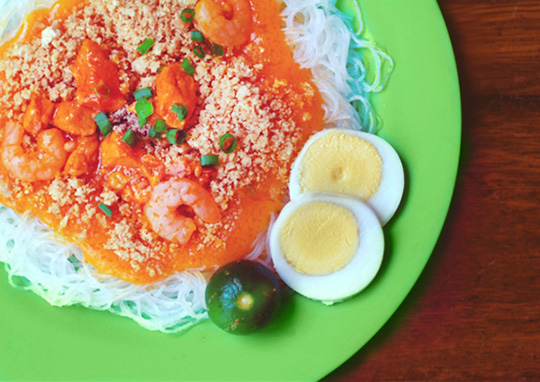
Compared to the heartbreakingly beautiful landscape and the warm hospitality of the people, food is still something that's not compelling enough to make our friends from around the world to visit more often. And that's a bit of a wonder since the Philippines is populated by food aficionados.
It is said that Filipinos are seafood diet practitioners...when we see food, we eat. Filipinos eat approximately eight times a day: Breakfast, snacks, lunch, merienda, merienda cena, dinner, midnight snacks, and the no-one-saw-me-take-that-cookie-from-the-fridge-so-it-doesn't-count snack.There's always a merienda or light snack in between meals and even a merienda after a merienda.
In a country where food is greatly appreciated but people are always willing to share, here's a list of authentic Filipino merienda that you should introduce your foreign friends to so that their stay here in the Philippines would be more memorable and also yummier.
1. Puto and Kutsinta
Puto is Filipino steamed rice cake which is eaten as is, or topped with butter, cheese, or salted egg. This all-time favorite merienda is also best paired with dinuguan (spicy pork blood stew), this may sound a bit strange, but it is really a must-try!
Kutsinta, on the other hand is a sticky rice cake which is usually served with fresh niyog on top. It's sticky and chewy texture with a hint of sweetness effectively made its way to stick in every Filipino merienda crave. These are the two Filipino native delicacies you surely don't want to miss.
2. Biko
Made from glutinous rice (or malagkit), Biko is also a local favorite. It is another Filipino sticky rice treat with latik (fried coconut milk curd) topping set at the center of every slice. This appetizing kakanin is traditionally served in round woven bamboo trays with banana leaves in special occasions like birthday parties, fiestas, and even in weddings. It is usually made to order but if you're lucky, you could find it being peddled in the streets together with the other rice treats.
3. Palabok
Palabok is a traditional Filipino noodle dish where thin rice noodles known as bihon is topped with bright colored orange savory sauce and a variety of other toppings such as shrimps, pork, crushed chicharon, tinapa flakes, hard-boiled egg slices, chopped green onions, and to add more flavor, a squeeze of calamansi for the finale.

The dish experience varies depending on the sauce, the ingredients used and also where it's made. However, you should have no worries since Pinoy Palabok can be found in Mang Inasal which has branches all over the country. Mang Inasal Palabok is known for its mouth-watering and savory thick sauce and exceptional ingredients. This Palabok will surely make you crave for more and save your taste buds from a mediocre merienda.
4. Ginataang Halo-halo
Notwithstanding its topsy-turvy name, Ginataang Halo-halo is hit Pinoy snack. It's typically made with plantains (or saging na saba), sweet potato, taro root, jackfruit, sago (tapioca pearls), whole kernel corn, and bilo-bilo (glutinous rice balls) cooked in coconut milk and usually served warm, perfect for rainy days.
5. Champorado
Champorado is a sweet chocolate rice porridge also made with glutinous rice and traditionally with tableya (pure cocoa blocks). Sugar and milk are usually added to make it sweeter and this can be served either hot or cold depending on your tastebuds.
It is also usually served with tuyo, which doesn't make much sense (sweet chocolate and then salty dried fish) until you taste it.
6. Halo-Halo
This dessert has always been the summer's best Filipino dessert. Staying true to its name, this is usually made up of the ff.: kaong (sugar palm fruit), macapuno (coconut sport), langka, kidney beans, garbanzos, plantain, tapioca pearls, gelatin, nata de coco (coconut gelatin), pinipig (rice crispies), kamote, sugar, and cheese. Crushed ices is then added to this sweet mixture and then finally, it will be topped with leche flan, ube (purple yam), and evaporated milk. This merienda-dessert is perfect for beating up the heat under the unusual sunny weather (for you).
7. Banana Cue, Turon, and Maruya
These three all-time-Pinoy-favorite-grab-and-go banana meriendas are present in almost every street corner. All three are made from plantain, the only difference is the way of cooking it. Banana Cue is made by coating the banana with brown sugar and deep frying it until the sugar caramelizes. On the other hand, for Turon, the plantain is encased with a spring roll wrapper together with langka strips, and fried after sprinkling some brown sugar. Maruya (banana fritter) is prepared by mixing the banana slices with the batter and rolling it on sugar after it was deep fried.
8. Carioca
Carioca is a sweet rice ball made with glutinous rice dough. It is deep-fried, dabbed with sweet coconut syrup and skewered with a bamboo stick. The highlight of this snack is the mouth-dripping crunchiness outside while it's hollow and stringy inside, with a twist of sweetness of the creamy coconut syrup.
9. Isaw
Isaw, one of the Philippines' exotic, is a grilled chicken or pork intestines that are usually dipped in suka (vinegar) with chili and spices. No worries because it is cleaned in a repetitive process and boiled before grilled on sticks. It is commonly sold by vendors as a street food. Though it may look weird or even yucky to you, it has the right taste that will tickle your taste buds into liking something new.
10. Kwek-kwek and Tokneneng
These two snacks are often confused from which is which, because both absolutely look the same except for size and the kind of egg used. Both are made by coating eggs with orange batter before deep frying it. Kwek-kwek has quail eggs, while Tokneneng has duck eggs and sometimes Balut.



